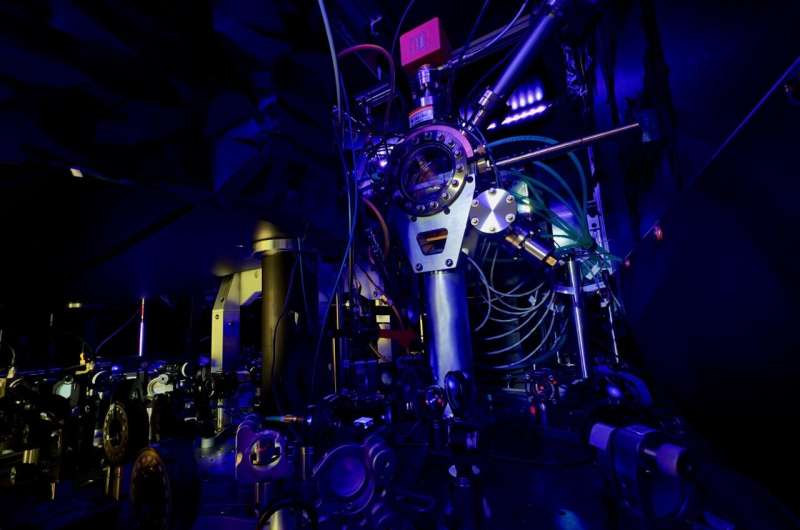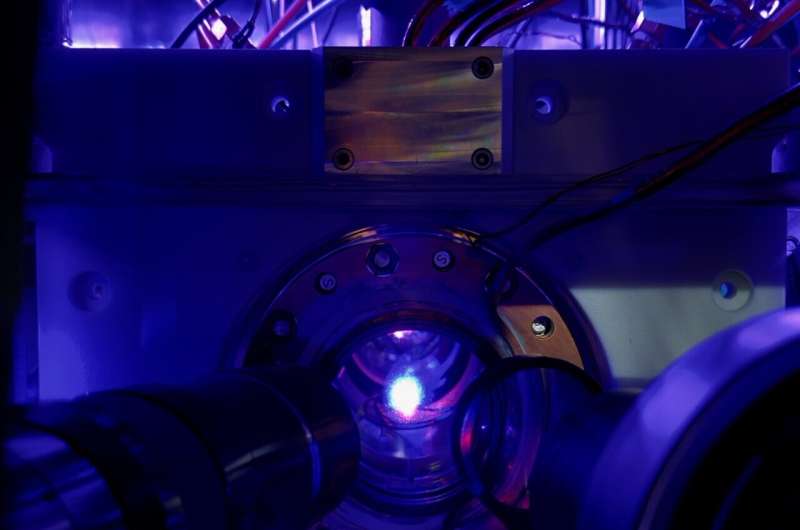July 24, 2024 feature
This article has been reviewed according to Science X's editorial process and policies. Editors have highlighted the following attributes while ensuring the content's credibility:
fact-checked
peer-reviewed publication
trusted source
proofread
An optical lattice clock based on strontium atoms achieves unprecedented accuracy

Researchers at the Ye Lab at JILA (the National Institute of Standards and Technology and the University of Colorado Boulder) and University of Delaware recently created a highly precise optical lattice clock based on trapped strontium atoms. Their clock, presented in a Physical Review Letters paper, exhibits a total systematic uncertainty of 8.1 x 10-19, which is the lowest uncertainty reported to date.
"This paper came out of a decades-long pursuit in the Ye lab towards building the best clocks," Alexander Aeppli, co-author of the paper, told Phys.org. "Measuring time is a fundamental task in physics, and each advancement in measurement precision and accuracy opens the door to studying new phenomena and creating new technologies."
Most existing time-keeping technologies specifically measure the period during which an electron oscillates in a cesium atom. These instruments are known as "microwave atomic clocks," as the frequencies of the oscillations they measure are in the microwave band, resembling the frequencies of electromagnetic oscillations inside a microwave oven.
"Many recent atomic clocks, ours included, use an 'optical' transition, where the frequency of the oscillation is similar to the frequency of visible light," Aeppli explained. "Using a much higher frequency is akin to using a ruler with finer ticks, subdividing a second further and immediately allowing for more precise timekeeping."
Much of the recent research carried out at the Ye Lab at JILA was aimed at developing atomic clocks that can measure time with high accuracy. The latest study by Aeppli and his colleagues builds on progress made both at the Ye Lab and at other institutes worldwide, which highlighted the potential of building precise optical lattice clocks using strontium atoms.
"A typical clock has three components: an oscillator, a counter, and a reference," Aeppli said. "In a classic pendulum clock, the oscillator is a pendulum that is swinging back and forth, once per second. A set of gears counts this swing and advances the second, minute, and hour hands. Finally, the reference is the position of the sun in the sky, where noon is when the sun is directly overhead."
Optical lattice clocks operate using the same three principles as conventional clocks. Yet in this type of clock, the oscillator, counter and frequency reference take a very different form.
In optical lattice clocks, the oscillator is comprised of an ultra-stable laser, while the counter is a so-called frequency comb (i.e., an instrument to measure optical frequencies by recording the repetition rate of a continuous sequence of light pulses). The frequency reference, on the other hand, consists of trapped atoms, which in the team's clock are specifically strontium atoms.
"The frequency comb is stabilized to the laser, and the laser is stabilized to a specific electronic transition in the strontium atoms," Aeppli said.
"Every few seconds we shine the laser on the atoms for 2.4s. If the laser has drifted from the atomic resonance, we correct this drift. The frequency comb converts optical frequencies to microwave frequencies, and the beauty of this device is that the frequency stability of the microwave frequency is the same as the optical frequencies."

After the frequency comb converts optical frequencies into microwave frequencies, the periods of these frequencies are analyzed by simple electronics to output 1 second, which is fundamentally tied to the frequency of the strontium transition. In the clock developed by Aeppli and his colleagues, the strontium atoms are trapped within a standing wave of light produced by two mirrors.
"Much like a lattice, atoms are confined to this light in a periodic way, with a cluster of a few atoms located every 0.5 um," Aeppli explained.
"This technology allows us to trap one-hundred thousand strontium atoms at a time, which means every time we make a measurement of the strontium transition frequency we can simultaneously measure many atoms, giving a very precise measurement. This is in contrast with ion optical clocks that use an electronic transition within a single trapped ion, meaning that every measurement is far noisier."
While optical lattice clocks have been previously found to keep time with outstanding accuracy, they can also come with limitations. Specifically, their underlying design based on the trapping of light can affect their accuracy, as it can shift the transition frequency.
Compared to previously proposed optical lattice clocks, the clock introduced by Aeppli and his colleagues utilizes lower intensity light trapping, which significantly boosts its accuracy.
"Many of our achievements in this work are relatively technical," Aeppli said. "One of the largest shifts in strontium optical lattice clocks comes from interactions with thermal emission from the surrounding environment. Now we are better able to characterize this effect and understand how it shifts the natural transition frequency of the strontium atom."
The work by this team of researchers highlights the huge potential of optical lattice clocks based on strontium atoms, suggesting that they could perhaps even contribute to the redefinition of the SI second. Aeppli and his colleagues hope that their findings will inform future studies in this area, paving the way for the development of increasingly precise clocks.
"On a wider scale, we hope our work shows that there is a continued path towards making more accurate clocks, and we have yet to see any fundamental limit to clock accuracy," Aeppli said.
"While we have constructed a clock with excellent accuracy, we have yet to use it to tell time. Yet it is important to compare clocks to understand their limitations. As in the past, we are currently working with colleagues at the National Institute of Standards and Technology (NIST) to compare with their platforms."
Researchers at the Ye Lab are currently performing various other clock experiments, each of which is aimed at devising approaches to build more advanced atomic clocks.
Two promising approaches they are exploring entail the use of quantum entanglement to reduce the noise associated with measuring the transition frequency and the use of a nuclear transition, which may yield even better accuracies.
More information: Alexander Aeppli et al, Clock with 8×10−19 Systematic Uncertainty, Physical Review Letters (2024). DOI: 10.1103/PhysRevLett.133.023401. On arXiv: DOI: 10.48550/arxiv.2403.10664
Journal information: Physical Review Letters , arXiv
© 2024 Science X Network





















